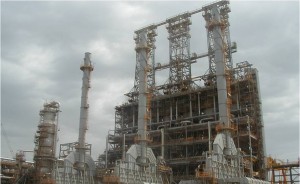A delayed coker is a type of coker whose process consists of heating the residual oil feed to its thermal cracking temperature in a multi parallel pass furnace. This cracks the long chain heavy carbon and hydrogen molecules of the residual oil into coker gas oil and pet coke. Cracking begins in the furnace, continues in the transfer line, and finishes in the coke drum. (wikipedia definition)
As cracking continues in the drum, gas oil and lighter components are generated in vapor phase and separate from the liquid and solids. The drum effluent is vapor only except for any liquid or solids entrainment, and is directed to a fractionation column where it is separated into the desirable boiling point fractions. Solid coke is deposited in the drum in a porous structure that allows flow through the pores. All solids and uncracked residual liquid produced from the vapor and liquid feed are intended to remain in the drum. After the drum is full of the solidified coke, the hot mixture from the furnace is switched to a second drum. While the second drum is filling, the full drum is steamed to further reduce hydrocarbon content of the pet coke, and then water quenched to cool it. The top and bottom heads of the full coke drum are removed, and the solid pet coke is then cut from the coke drum with a high pressure water nozzle, where it falls into a pit, pad, or sluiceway for reclamation to storage.
Larger cokers have several pairs of tandem drums.
 Learn more:
Learn more:
Delayed Coking Fundamentals (PDF)
Prepared by Paul J. Ellis and Christopher A. Paul
Delayed Coking produces 19% of finished product exports according to EIA.
Attend Delayed Coker Operations and Reliability Training or Delayed Coking Process, Design and Troubleshooting Training Courses. Upcoming training in Galveston, Buenos Aires, Valencia, Spain. Schedule custom onsite DCU training.
Listen to Coker Technical Papers, Workshops, Best Practices and Lessons Learned at a RefComm® Conference.
Find out how to get coker consulting at your site.







Leave a Reply
You must be logged in to post a comment.